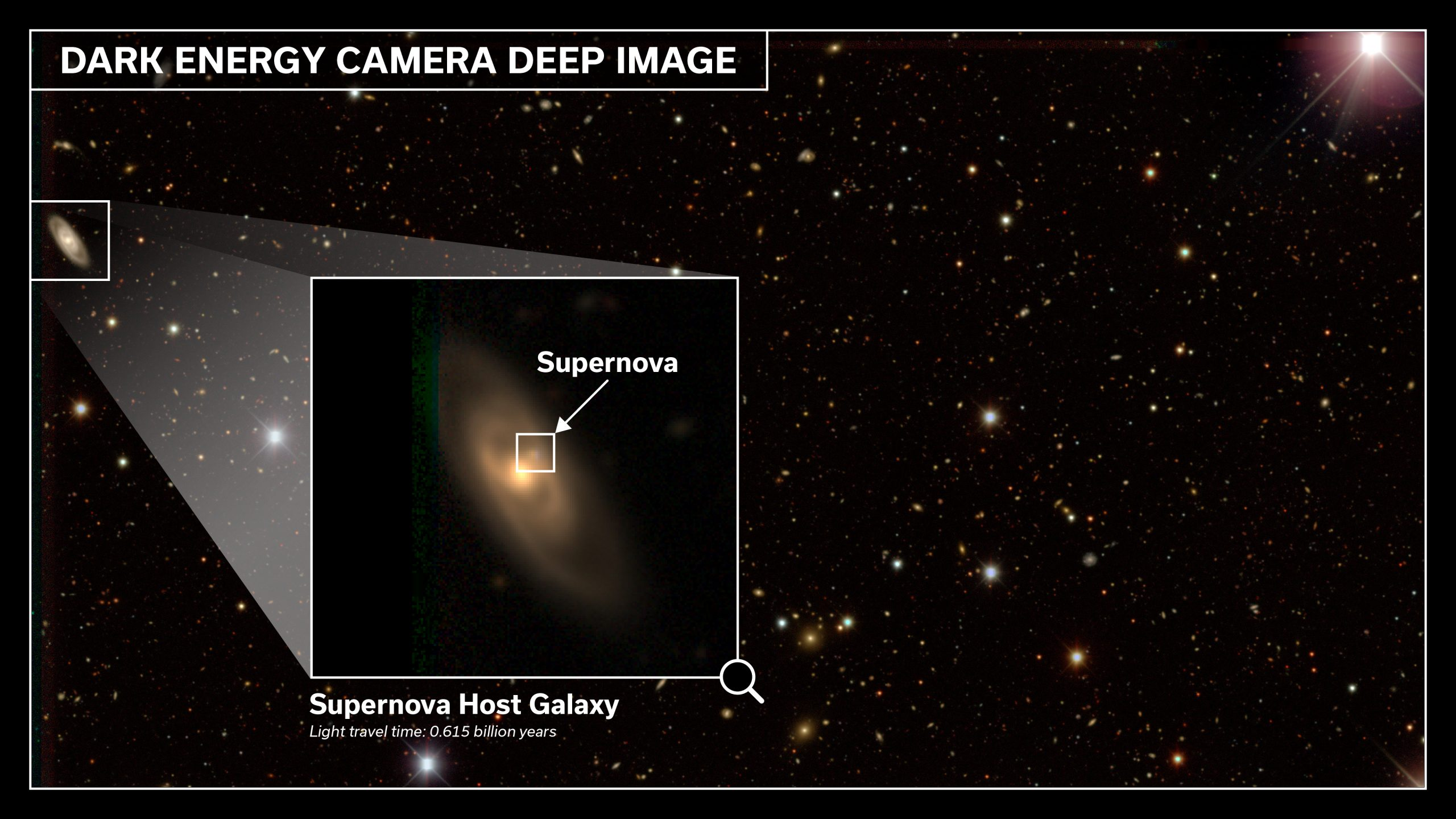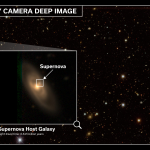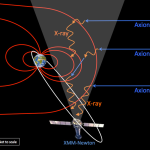Dark energy analysis has become a pivotal focus in modern cosmology, shedding light on the enigmatic forces behind the universe’s expansion. Recent findings from the Dark Energy Spectroscopic Instrument (DESI) collaboration indicate that dark energy, often regarded as a cosmological constant, may not be as stable as previously thought. This breakthrough analysis, based on extensive data collection spanning 11 billion years, suggests the influence of dark energy might be evolving in unexpected ways. Understanding how this force interacts with matter is crucial, as it directly impacts theories surrounding the universe’s future and its accelerating expansion. By utilizing advanced techniques such as Baryon Acoustic Oscillations, scientists are piecing together a more comprehensive picture of how dark energy shapes the cosmos.
Exploration of the cosmos has led to intense scrutiny of forces like dark energy, which underlies the accelerated growth of our universe. This phenomenon, often termed the cosmological constant, is at the heart of new inquiries arising from the DESI initiative, aimed at mapping our celestial surroundings in unprecedented detail. As astrophysicists delve into concepts such as cosmic expansion and matter distribution, the implications of dark energy’s potential variability become increasingly significant. The ongoing research, tapping into patterns left over from the early universe, allows for deeper insights into the dynamics of cosmic evolution. Ultimately, this avenue of study not only enhances our understanding of the universe but also raises important questions about its ultimate fate.
Understanding Dark Energy’s Role in Universe Expansion
Dark energy is an enigmatic force believed to be responsible for the accelerating expansion of the universe. This phenomenon has baffled astrophysicists since its inception, as it constitutes about 68% of the universe’s total energy density. The concept of dark energy, often equated with a ‘cosmological constant,’ suggests a uniform energy density filling space homogeneously. Recent findings from collaborations like DESI have raised intriguing questions about the nature of dark energy and its potential change over time, which could fundamentally alter our understanding of cosmic dynamics.
The implications of these findings reveal a delicate balance between matter and dark energy that determines the universe’s fate. As dark energy continues to drive the expansion, its evolving strength may lead to significant shifts in cosmological models. By analyzing Baryon Acoustic Oscillations, scientists can trace back the effects of dark energy across billions of years. This analysis fosters a clearer understanding of how the universe has expanded and evolved, potentially leading to a revised comprehension of cosmic history.
The DESI Collaboration: Pioneering Dark Energy Research
The Dark Energy Spectroscopic Instrument (DESI) collaboration represents a monumental effort by over 900 scientists from more than 70 institutions to unravel the mysteries of dark energy. Spearheaded by key research institutions such as Harvard, DESI has quickly become a centerpiece in astrophysical research focusing on the cosmos’s structure and evolution. This global collaboration has produced the largest three-dimensional map of the universe, providing unparalleled insights into the distribution of galaxies and the impact of dark energy over an extensive timeline.
By employing sophisticated techniques, the DESI collaboration analyzes data gathered from more than 14 million galaxies and quasars. Their rigorous examination of Baryon Acoustic Oscillations offers crucial information regarding the expansion dynamics of the universe. With each data release, researchers can explore new patterns and make informed predictions about the universe’s future. The ongoing efforts of this collaboration not only expand our knowledge of dark energy but also set the stage for innovative discoveries in cosmology and astronomy.
Furthermore, the public outreach facilitated by DESI underlines the significance of collaboration in scientific advancement. Resources such as the comprehensive catalog of celestial objects now available for public exploration underscore the importance of making complex astrophysical data accessible to broader audiences. By encouraging public engagement, the DESI collaboration enhances the understanding and appreciation of dark energy research among enthusiasts and professionals alike.
Baryon Acoustic Oscillations: A Key to Understanding Dark Energy
Baryon Acoustic Oscillations (BAOs) are ripples in the density of visible matter of the universe that offer a unique perspective on the oblique influence of dark energy through cosmic history. These oscillations are crucial for determining the universe’s expansion rate at different epochs. As waves traveled through the plasma in the early universe, their gravitational effects left imprints on the structures we observe today, acting as a cosmic ruler. Studying these patterns helps scientists gauge the influence of dark energy over time and allows for the measurement of the universe’s growth rate.
Using BAOs as a cosmological tool, researchers can refine their models of the universe’s expansion, enabling a more accurate assessment of dark energy’s impact. The findings from the DESI collaboration indicate that as the universe evolves, the influence of dark energy may not remain constant. Understanding BAOs enhances our insight into the nature of dark energy, making it possible to detect subtle shifts that could indicate a changing cosmological constant and, consequently, an evolving fate for the universe.
The Cosmic Web: Exploring the Structure of the Universe
The cosmic web is a vast and intricate structure formed by the gravitational effects of dark matter and baryonic matter in the universe. It consists of galaxies, galaxy clusters, and filaments of dark matter that interconnect them. The study of this cosmic web has become a crucial aspect of modern astrophysics, especially in understanding how dark energy plays a role in the large-scale structure of the universe. The interactions between dark energy and matter in the cosmic web inform researchers on how gravitational forces have shaped the universe over billions of years.
Recent advancements in map creation, primarily thanks to the DESI collaboration, have allowed scientists to visualize the cosmic web more effectively than ever before. By mapping the distribution of over 14 million galaxies, researchers can track the development of cosmic structures over time and analyze how dark energy influences their formation and evolution. These detailed investigations provide insight into the interplay between dark energy and the observable universe, ultimately enriching our understanding of cosmic history and the forces at play.
Future Implications of Dark Energy Analysis
The analysis of dark energy could have profound implications for our understanding of the universe’s fate. Current models predict scenarios ranging from continued expansion to a potential collapse; however, recent findings suggest that as dark energy may be weakening, this could dramatically modify these predictions. For example, if dark energy’s influence continues to diminish, galaxies may begin to coalesce, leading to a denser universe in the far future. These findings challenge long-held assumptions and emphasize the need for continuous investigation into the ever-evolving landscape of cosmology.
Moreover, understanding dark energy’s trajectory may influence technologies and methodologies in various fields. As scientists probe deeper into cosmic origins, insights garnered from dark energy studies may spark innovations in technology, data processing, and simulation approaches. A collaborative approach between astrophysicists and technologists could pave the way for breakthroughs that extend far beyond the realm of cosmology, harnessing knowledge to solve problems in energy utilization, computation, and beyond.
The Role of Public Outreach in Astrophysics
Public outreach plays a pivotal role in the world of astrophysics, especially concerning complex subjects like dark energy. Initiatives by the DESI collaboration aim to bridge the gap between scientists and the general public, emphasizing the importance of engaging non-experts in scientific conversation. By providing access to data and educational resources, outreach efforts foster a sense of wonder and inquiry, encouraging the next generation of scientists and informed citizens to participate in cosmic exploration.
Educational initiatives and events, such as lectures and community workshops, help demystify the concepts of dark energy and offer avenues for the public to qualify their understanding. As citizens become educated about ongoing research and advancements, they are better equipped to engage in discussions about the universe’s future and appreciate the intricate workings of cosmology. Ultimately, this engagement cultivates a broader appreciation for science as a crucial aspect of human inquiry.
Collaborative Advances in Dark Energy Research
Collaboration is at the heart of progress in dark energy research, with the DESI initiative exemplifying how collective effort can amplify scientific discovery. Bringing together researchers from diverse backgrounds and institutions enhances the ability to tackle complex questions surrounding the universe’s structure and evolution. By pooling resources, expertise, and data, teams can pursue ambitious observational projects, such as mapping the universe, researching cosmic phenomena, and sharing findings openly with the scientific community and the public.
Such collaborations not only facilitate groundbreaking discoveries but also set a precedent for future scientific ventures. As astrophysics increasingly requires sophisticated technology and extensive datasets, the importance of partnerships among scientists, engineers, and institutions cannot be overstated. Collaborative platforms promote dialogue, inspire innovation, and allow broader and more inclusive participation in the scientific process, ultimately fostering an environment where dark energy and cosmological research can flourish.
Dark Energy’s Evolution: A Paradigm Shift in Cosmology?
The concept of a changing dark energy is intriguing and can signify a paradigm shift in cosmology. Traditional models often depict dark energy as static and uniform, identified primarily with Einstein’s cosmological constant. However, the latest DESI findings raise the possibility that dark energy’s influence may vary across time and space. Such a shift in our understanding could necessitate a re-evaluation of existing cosmological theories, potentially leading to a more dynamic conception of universe expansion.
If dark energy is indeed changing, the repercussions could extend beyond theoretical frameworks, affecting how future research is conducted. A new focus on monitoring the evolution of dark energy could inspire innovative explorations, even developing new theories that incorporate variable cosmic dynamics. The potential for discovering different phases of dark energy introduces exciting horizons in astrophysics, heralding a new era of investigations into the fundamental components steering the universe’s fate.
The Importance of Continuous Study in Cosmology
Continuous study in cosmology is vital not only for advancing our understanding of dark energy but also for ensuring that scientific knowledge remains relevant in light of new discoveries. As seen with the ongoing DESI collaboration, gathering data over extended periods allows researchers to witness and analyze patterns that might otherwise go unnoticed. This accumulative approach provides invaluable insights into changing phenomena, including the ever-complex relationship between dark matter, dark energy, and the expansion of the universe.
In addition, ongoing studies foster the refinement of existing models, providing opportunities to reassess theoretical frameworks in light of new evidence. The rapid evolution of technology in data collection, analysis, and computational simulations further underscores the importance of keeping pace with discoveries. As scientists dive deeper into the cosmos, continuous study ensures that our understanding of dark energy and the universe evolves coherently, paralleling any shifts in observed phenomena.
Frequently Asked Questions
What is dark energy analysis and why is it important in cosmology?
Dark energy analysis involves studying the mysterious force driving the accelerated expansion of the universe. Understanding dark energy is crucial as it influences the universe’s fate and challenges our current cosmological models, particularly in relation to the cosmological constant.
How does the DESI collaboration contribute to our understanding of dark energy?
The DESI collaboration significantly enhances our understanding of dark energy by creating the largest 3D map of the universe. This extensive dataset allows researchers to analyze the effects of dark energy over billions of years, thereby providing insights into its nature and potential changes.
What are Baryon Acoustic Oscillations and how do they relate to dark energy analysis?
Baryon Acoustic Oscillations (BAOs) are patterns in the distribution of matter in the universe, resulting from sound waves in the early universe. These patterns serve as ‘standard rulers’ to measure distances, crucial for assessing the impact of dark energy on universe expansion over time.
What recent findings have emerged from dark energy analysis using DESI data?
Recent findings suggest that dark energy, previously considered a static cosmological constant, may be weakening over time. This significant revelation, based on three years of DESI data, implies that our understanding of universe expansion may need reevaluation.
How does dark energy influence the expansion of the universe?
Dark energy is believed to be the driving force behind the accelerated expansion of the universe. Its presence affects the dynamics of cosmic expansion, impacting how galaxies move apart and how the overall structure of the universe evolves.
What are the long-term implications of understanding dark energy through studies like those conducted by the DESI collaboration?
Understanding dark energy is foundational for predicting the universe’s fate. Studies like those from the DESI collaboration could lead to groundbreaking insights, potentially altering our knowledge of cosmology and prompting new theories about the fundamental workings of the universe.
How can the public access DESI’s dark energy findings and data?
The DESI collaboration has made its findings available through multiple papers on arXiv and public presentations. Their Data Release 1 provides comprehensive data on millions of celestial objects, which is accessible for further exploration and research.
Who are the key researchers involved in the dark energy analysis at the Center for Astrophysics?
Key researchers from the Center for Astrophysics | Harvard & Smithsonian involved in dark energy analysis include Daniel Eisenstein, who co-developed essential algorithms, Cristhian Garcia Quintero, and Michael Rashkovetskyi, who performed critical distance calculations.
| Key Point | Details |
|---|---|
| Dark Energy Analysis | Recent findings from DESI collaboration indicate that dark energy, previously considered constant, may be weakening. |
| Impact on Universe’s Future | The balance between matter and dark energy is crucial for understanding the universe’s accelerating expansion. |
| DESI’s Methodology | DESI analyzes the distribution of matter over 11 billion years using the largest 3D map of the universe. |
| Baryon Acoustic Oscillations | These patterns serve as a standard ruler for measuring changes in dark energy’s strength. |
| Contributions from CfA | Key researchers from CfA contributed algorithms, simulations, and calculations to enhance the findings. |
| Collaboration Reach | DESI involves over 900 researchers across 70 institutions, managed by Berkeley Lab. |
| Public Access to Data | Data Release 1 is now available for public exploration, aiding further astrophysical research. |
Summary
Dark energy analysis is at the forefront of modern cosmological research, challenging previous assumptions about the universe’s expansion dynamics. The latest findings from the DESI collaboration suggest that dark energy might not be constant as previously thought, but rather may be changing over time. This revelation prompts a reconsideration of the fundamental models of the universe, potentially leading to new insights into its ultimate fate. As researchers continue to study the complexities of dark energy, they aim to unravel its mysteries, providing a deeper understanding of cosmic evolution and structure.








